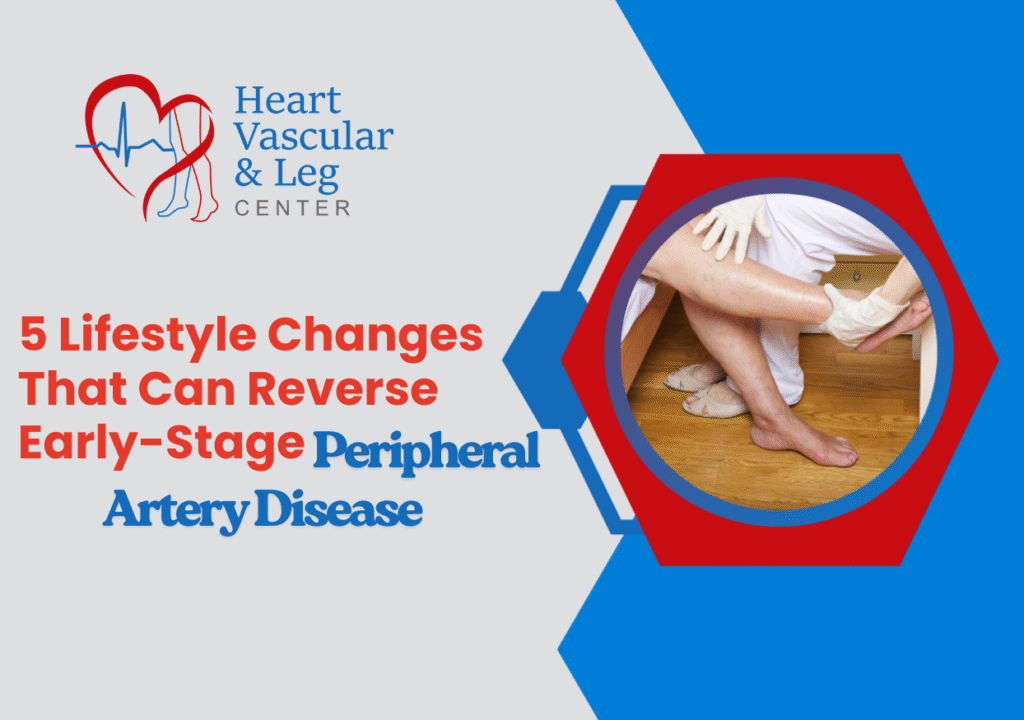
Learning that one has peripheral artery disease (PAD) may be frightening.
It is a condition wherein the arteries of your legs and feet get narrow, causing blood flow to slow down and most of the time painful, cramping, or even numb.
Despite the alarming diagnosis, PAD is reversible, and even in its initial stages, it can be controlled, provided that you make several significant lifestyle changes.
Deliberate and planned changes in your daily lifestyle would have a great impact on your vascular condition.
It is more than symptom management; it is a process of control and internal enhancement of your circulation.
We will walk through five practical changes you can begin to make today to support your body in healing and putting you back on your feet, feeling stronger and energetic.
The last thing you may feel like doing when you have leg pain is to exercise. Nevertheless, an early-stage PAD responds well to walking.
It may seem to be a simple process, but a structured walking program can work miracles!
As you walk, your leg muscles require more oxygenated blood!
This stimulates your body to form newer and smaller blood vessels, which circumvent the narrowed arteries. This is called the development of collateral circulation.
Imagine that your body is making some natural reroutes through which blood circulates around the obstacles.
This enhances blood flow, relieves pain, and you tend to walk longer as time passes.
The food you consume actually has a direct relationship with the health of your arteries!
PAD is brought about by atherosclerosis. This is the deposition of plaque (fat, cholesterol and other substances) in your vessels.
This accumulation can be slowed, prevented or even reversed by a diet that combats inflammation and reduces cholesterol.
Strive to reduce:
• Saturated and trans fats
• Sodium
• Added sugar
They tend to be found in processed foods, fried food, soda and fatty meat.
Minor replacements, like salt with herbs, can count.
The most important risk factor of PAD development and worsening is smoking.
Tobacco smoke causes the damage of the lining of your arteries, and the accumulation of plaque becomes easier.
Smoking also narrows your blood vessels and reduces blood flow to your body, legs and feet even more.
Giving up is not easy and yet it is the most effective action you can take concerning your vascular health.
Your circulation improves in a short period when you quit. Your chances of heart attack and stroke are reduced drastically as well as amputation.
Talk to your provider if you need anything. Resources are numerous, including counseling and medications, which might help you on your way to being smoke-free!
One of the greatest risk factors of peripheral artery disease development and exacerbation is diabetes.
With blood sugar constantly high, they lead to extensive damage of all blood vessels in your body including the arteries of your legs and feet.
Excess sugar is like sandpaper on the lining of your blood vessels, which causes inflammation and leaves the walls of the arteries sticky.
This defected surface turns into a receptacle of cholesterol and other materials increasing the rate of plaque formation.
PAD usually accompanies companions, such as high blood pressure, high cholesterol and diabetes. It is important to control these conditions to prevent the progression of PAD.
Inefficient circulation exposes your legs and feet to more damage and heals more slowly. A simple laceration or blister may develop into a severe issue when not attended to.
These lifestyle changes are a mighty beginning, but you do not need to go it alone. It is also important to have the right medical team that is by your side.
Here at Heart Vascular and Leg Center, our professionals will focus on patient-first diagnosis and treatment of PAD.
Facing a vascular condition can be stressful, and we’re here to listen to your concerns and create a personalized treatment plan.
We focus on minimally invasive procedures. These aim to restore blood flow and avoid amputations to help you get back to work and a quality of life.
The changes in the above lifestyle, as well as a professional medical consultation, will help you cope with your condition, and improve your long-term well-being.
Our staff at Heart Vascular and Leg Center is ready to offer you the high-quality and caring care you can receive! Make an appointment.
How to heal PVD naturally?
Peripheral Vascular Disease (PVD), including PAD, has a focus on natural healing that involves lifestyle changes.
Can you live a full life with peripheral artery disease?
Yes, you absolutely can.
Most PAD patients can live full and active lives and this is possible through proper management, which includes lifestyle modification and medical management.
Timely diagnosis and regular attention are the most important to avoid complications and be able to move.
What not to do with peripheral artery disease?
© Copyright 2024 Vascular Health Partners LLC. All Rights Reserved
Designed By CyberWorx